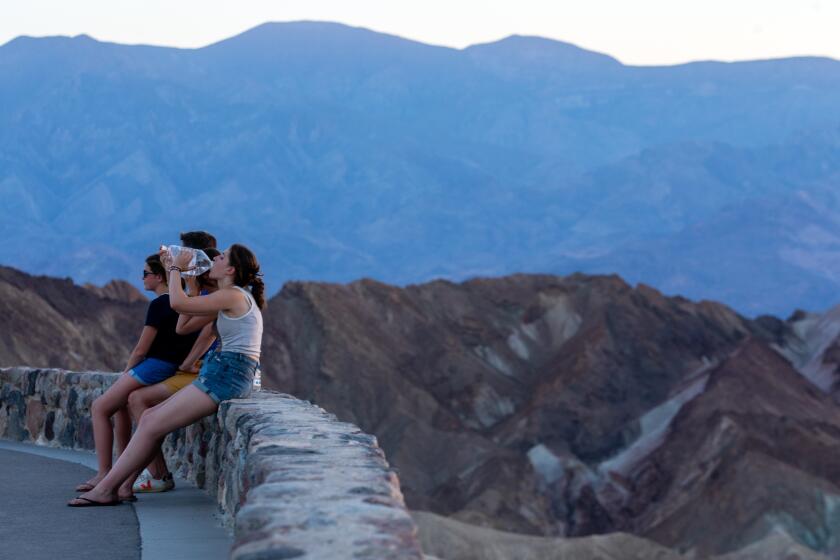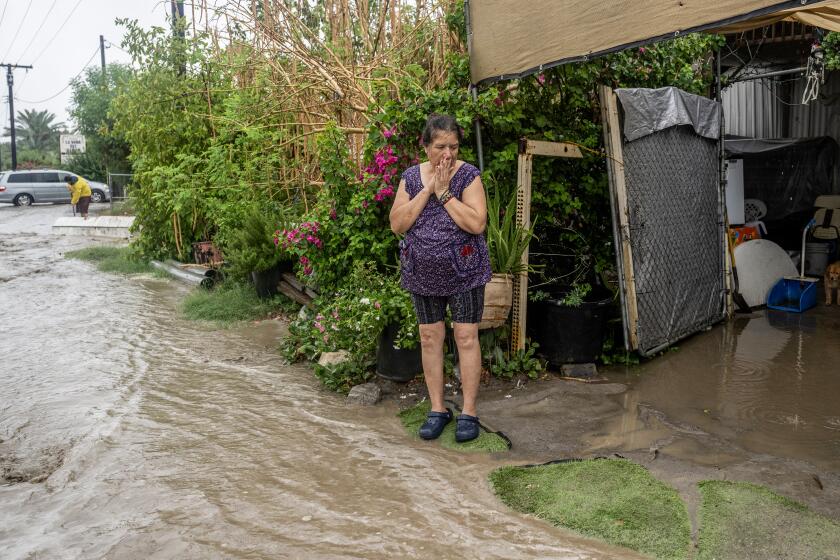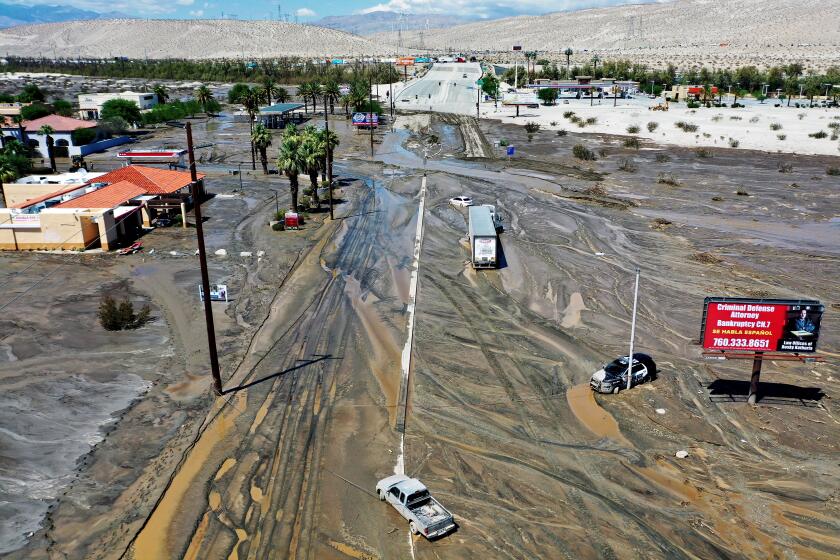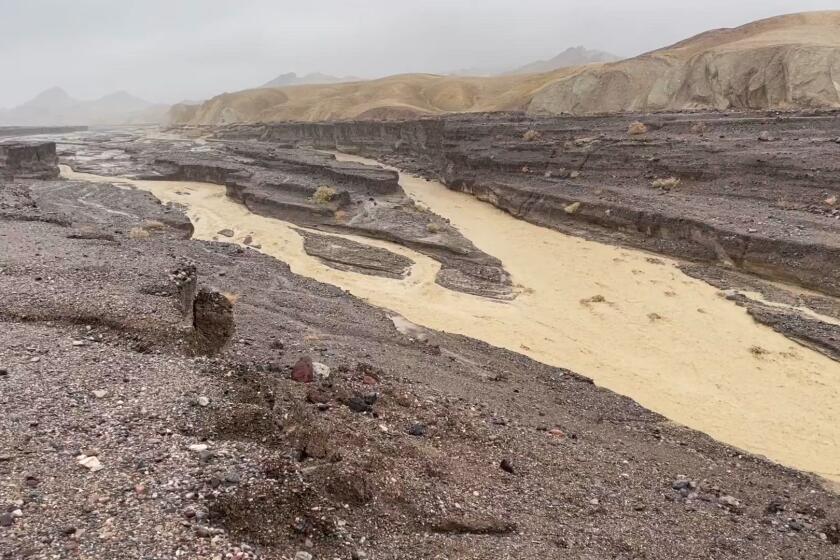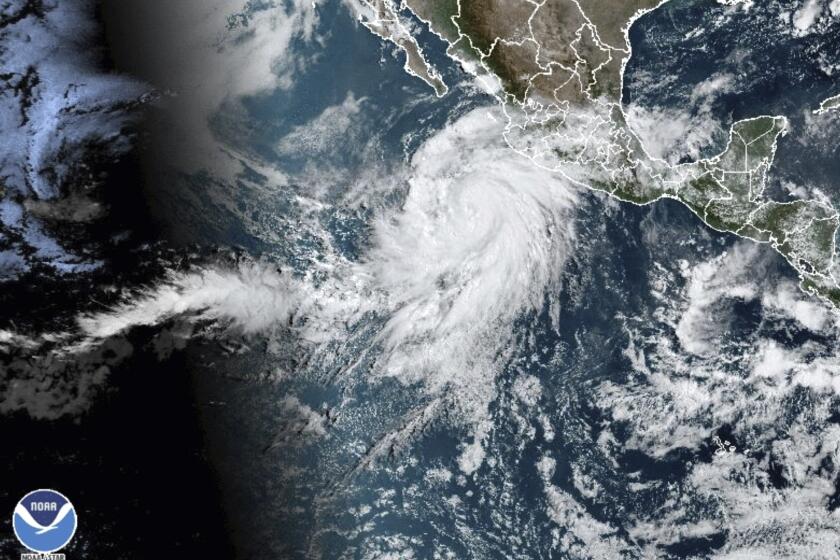‘I think I’ll be able to get out today’: Residents trapped by Tropical Storm Hilary begin to dig out
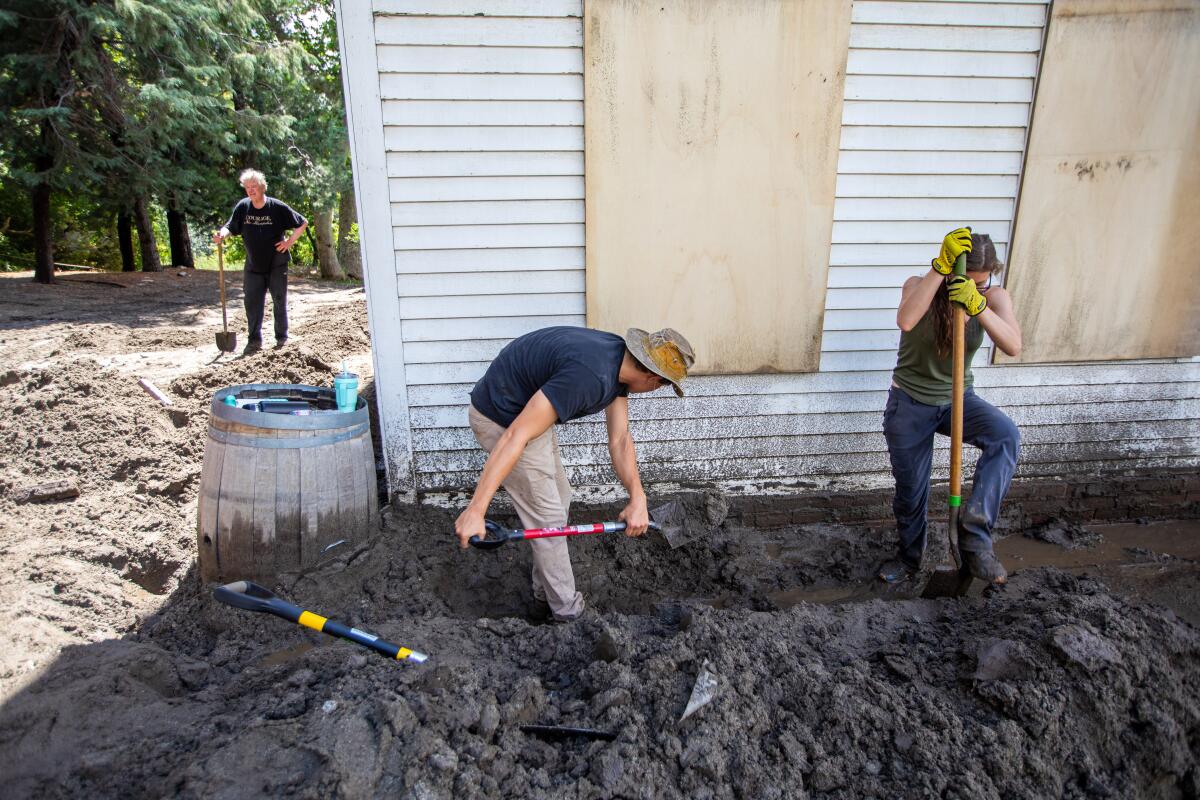
- Share via
With the sun shining and the rain brought on by Tropical Storm Hilary gone, Lucy Beeson peeked out of her Lancaster home and decided she could finally go outside.
The storm drenched Southern California with record rainfall, leaving behind residual floodwaters in the Antelope Valley that trapped Beeson, 78, in her home Sunday and Monday.
By Tuesday morning, looking out her front door, Beeson could see that the water had receded.
“I think I’ll be able to get out today. I’m not sure,” she said. “It was pretty bad. The water was all the way up to my neighbor’s knees and he’s a tall man. I was too afraid to go outside, but we saw some of the neighborhood kids playing in the water.”
In the aftermath of the first tropical storm to hit Southern California in decades, residents throughout the Inland Empire and the San Bernardino Mountains were beginning Tuesday to find their way out from behind the mud and debris flows and floodwaters that trapped many since the downpours began in earnest Sunday afternoon.
Authorities reported few injuries in the region, but several trapped residents had to be rescued by helicopter and a man who was caught in fast-moving waters in Chino Hills was plucked out by firefighters. As of Tuesday morning, rescue teams were still working to get access to some residents in hard-hit San Bernardino mountain communities. At least one woman remained unaccounted for in the Seven Oaks area, according to Eric Sherwin, spokesperson for the San Bernardino County Fire Department.
Death Valley, one of the most extreme places on the planet, is already seeing the impact of climate change, with summers even hotter than usual.
Beeson said she got a call from the city Monday evening with an update on post-storm conditions in Lancaster, but she explained that flooding is nothing new in her neighborhood, where she has lived for 12 years.
“This happens every year,” she said. “This year’s the worst. Every time we have a storm, we get flooded in. Every time we see that a storm is coming, my husband and I go out and get provisions.”
Lancaster received 4½ inches of rain, and spokesperson Brianne Terrell said the city identified three major areas that require debris removal, with cleanup and recovery efforts likely to take the rest of the week.
There were no reported injuries among the 170,000 residents, but a significant portion of the community has “experienced disruptions” due to the storm, Terrell said.
Lancaster Mayor R. Rex Parris credited the city’s public works department for preparing ahead of the storm and working to unclog drainage systems.
“With the spirit of collaboration and unity, I am confident we will shine brighter than ever,” Parris said in a statement.
After days of urgent warnings, Tropical Storm Hilary made landfall in Baja California on Sunday, turning roads into rivers and imperiling homes before barreling north toward Southern California.
Farther south, Palmdale received almost 4 inches of rain, which accounts for nearly half of the year’s average total rainfall for the area, according to meteorologist Mike Woodruff of the National Weather Service in Oxnard.
“It was a substantial storm, with significant flooding as a result,” Woodruff said.
The downpour caused a large retaining wall in Palmdale to collapse Sunday evening, severely damaging multiple homes, said Capt. Sheila Kelliher with the Los Angeles County Fire Department. Crews on Monday evening were moving large sections of dirt and mud from the damaged wall near 25th Street and Avenue S. There were no reported injuries.
“There is residual flooding in the Antelope Valley, but it’s dissipating,” Kelliher said. “You’re still seeing that residual flooding in areas that is impacting access.”
Overall, the region has fared well against the storm, she said, crediting emergency crews for being prepared and residents for heeding the warnings to stay out of dangerous situations.
Hilary, the first tropical storm to hit Los Angeles in 84 years, was full of surprises, battering some Southern California areas but sparing others.
A man was rescued from the San Antonio River in Chino Hills on Sunday evening by a helicopter crew with the Los Angeles County Fire Department. Officials received reports of a person in the water, and the rescue helicopter crew was able to hoist the man out of fast-moving water and transport him in critical condition to a local hospital, Kelliher said.
“The person was going fast in the water and the crew thought they lost him at one point, because he went under,” she said. “It was a dramatic rescue.”
Emergency responders working in the hard-hit San Bernardino mountain communities airlifted one woman with non-life-threatening injuries from the Seven Oaks area, and continued searching for the missing woman, who was reported in her mobile home before it was swept off its foundation by floodwaters, Sherwin said.
Seven Oaks, Forest Falls and Oak Glen experienced flooding and debris flows from the storm that marooned residents for at least two days. Several residents in the Seven Oaks mobile home community were cut off from outside access, without water or power and accessible only by helicopter, Sherwin said. He estimated there were 15 residents still stuck Tuesday; some were airlifted out Monday.
“With limited access, we’re flying in there,” Sherwin said Tuesday morning.
A 200-foot section of Glass Road, Seven Oaks’ only connection to Highway 38 — the region’s main artery — was wiped out by flash flooding, Sherwin said. Firefighters are working to build a footbridge over the Santa Ana River to allow residents to leave, he said.
Visitors probably won’t be able to drive out until Tuesday, according to a park official.
Officials were able to clear portions of the roadways that had cut off two other mountain communities — Forest Falls and Oak Glen — after flash flooding, Sherwin said, allowing single-lane or emergency traffic through.
A washout forced the California Department of Transportation to close a 15-mile stretch of Highway 38 near Seven Oaks toward Big Bear early Tuesday, the agency said in a news release.
Almost 50 miles of Highway 62, the main artery north of Joshua Tree National Park, remained closed because of debris flow and shoulder erosion. The national park opened for day use Tuesday, but some roads are still inaccessible and campgrounds remain closed as rangers continue to assess damage from heavy flooding.
In Inyo County, multiple roads in the Alabama Hills National Scenic Area remain closed from storm damage, according to the Bureau of Land Management, while all of Death Valley National Park remains closed after flash floods and mudflows washed through the area.
An unprecedented tropical storm watch has been issued for Southern California as Hilary barrels north toward the United States.
More to Read
Sign up for Essential California
The most important California stories and recommendations in your inbox every morning.
You may occasionally receive promotional content from the Los Angeles Times.
